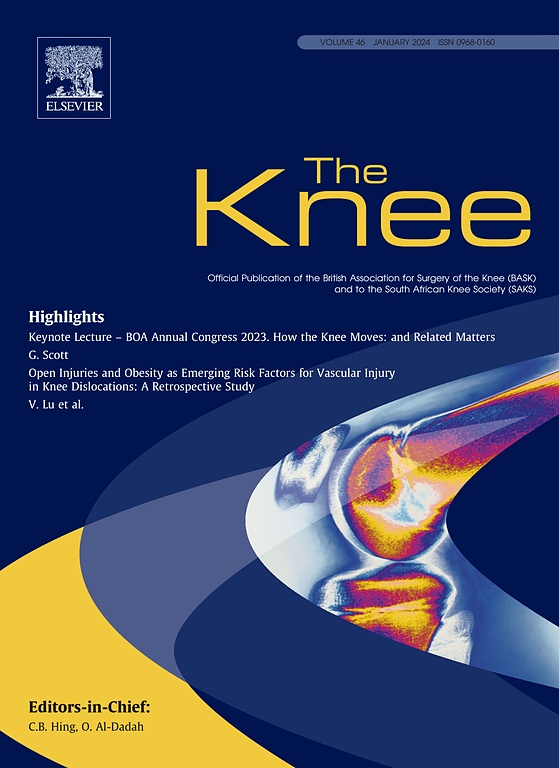
Mobile bearing UKA provides similar results to TKA for knee OA

Mobile bearing UKA provides similar results to TKA for knee OA
Mobile bearing UKA compared to fixed bearing TKA: a randomized prospective study
Knee. 2012 Mar;19(2):103-6. Epub 2011 Feb 22.Did you know you're eligible to earn 0.5 CME credits for reading this report? Click Here
Synopsis
56 patients suffering from unicompartmental osteoarthritis were randomized to either undergo unicompartmental knee arthroplasty (UKA) or total knee arthroplasty (TKA) to compare clinical and functional results. At an average of 52 month follow-up, UKA provided similar functional outcomes to TKA, while requiring less surgical time and fewer blood transfusions.
Was the allocation sequence adequately generated?
Was allocation adequately concealed?
Blinding Treatment Providers: Was knowledge of the allocated interventions adequately prevented?
Blinding Outcome Assessors: Was knowledge of the allocated interventions adequately prevented?
Blinding Patients: Was knowledge of the allocated interventions adequately prevented?
Was loss to follow-up (missing outcome data) infrequent?
Are reports of the study free of suggestion of selective outcome reporting?
Were outcomes objective, patient-important and assessed in a manner to limit bias (ie. duplicate assessors, Independent assessors)?
Was the sample size sufficiently large to assure a balance of prognosis and sufficiently large number of outcome events?
Was investigator expertise/experience with both treatment and control techniques likely the same (ie.were criteria for surgeon participation/expertise provided)?
Yes = 1
Uncertain = 0.5
Not Relevant = 0
No = 0
The Reporting Criteria Assessment evaluates the transparency with which authors report the methodological and trial characteristics of the trial within the publication. The assessment is divided into five categories which are presented below.
3/4
Randomization
3/4
Outcome Measurements
4/4
Inclusion / Exclusion
2/4
Therapy Description
4/4
Statistics
Detsky AS, Naylor CD, O'Rourke K, McGeer AJ, L'Abbé KA. J Clin Epidemiol. 1992;45:255-65
The Fragility Index is a tool that aids in the interpretation of significant findings, providing a measure of strength for a result. The Fragility Index represents the number of consecutive events that need to be added to a dichotomous outcome to make the finding no longer significant. A small number represents a weaker finding and a large number represents a stronger finding.
Why was this study needed now?
Total knee arthroplasty, the current standard for treatment of knee osteoarthritis requiring replacement, may be an excessive treatment for patients suffering from only medial compartment osteoarthritis. Unicompartmental knee arthroplasty (UKA) provides theoretical advantages when compared to TKA, which include: a smaller incision size, reduced muscular dissection, less postoperative pain, less blood loss, shorter operative times,and quicker rehabilitation. These possible advantages merit an investigation comparing the results of TKA and UKA for patients with unicompartmental osteoarthritis.
What was the principal research question?
Does mobile bearing unicompartmental knee arthroplasty provide similar functional results when compared to fixed bearing total knee arthroplasty for patients with unicompartmental knee osteoarthritis, while incurring fewer related costs and risks, as evaluated over 52 months?
What were the important findings?
- Significantly less blood was lost during the UKA procedure, inferred by the change in hemoglobin (1.6g/dl (SD 0.7; Range: 0.4 to 3.0) compared to TKA 2.7g/dl (SD 1.6; Range: 0.9 to 5.8 (p=0.007)). Total postoperative drainage was significantly lesser in UKA 436 ml (SD 14; range 100 to 380) compared to 512 (SD 11; range 60 to 910) in TKA (p<0.01).
- Average operation time was 68.8 min (range: 50 to 102) in UKA compared to 81.5 min in TKA (range: 56 to 115) (p<0.01).
- Deep vein thrombosis following the operation was more prevalent in the TKA group with 7 of 56 compared to 3 of 56 (p<0.01)
- There were no differences between Knee Society scores of the two groups (80.58 (Range: 70 to 100) UKA and 78.9 (Range: 70 to 87) TKA), indicating similar functional recovery (p>0.05). There were also no differences in ROM between the two groups (UKA: 115 (SD 4) vs. TKA: 117 (SD 7); p=0.18).
- 7 UKA patients underwent conversion to TKA
What should I remember most?
Unicompartmental knee arthroplasty provides similar clinical results compared to total knee arthroplasty for patients suffering from unicompartmental knee osteoarthritis. However, UKA was associated with significantly lower blood loss and operation time.
How will this affect the care of my patients?
The authors suggest that UKA should be considered as the primary treatment for unicompartmental knee osteoarthritis once surgeons are competent. However, this opinion is based on the assumption of reduced cost and risk, which needs to be conclusively supported using high quality RCTs.
Learn about our AI Driven
High Impact Search Feature
Our AI driven High Impact metric calculates the impact an article will have by considering both the publishing journal and the content of the article itself. Built using the latest advances in natural language processing, OE High Impact predicts an article’s future number of citations better than impact factor alone.
Continue



 LOGIN
LOGIN

Join the Conversation
Please Login or Join to leave comments.